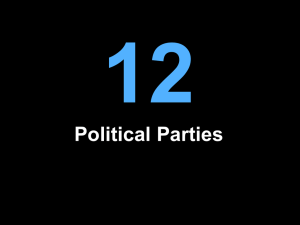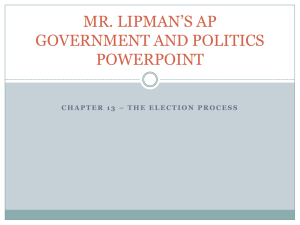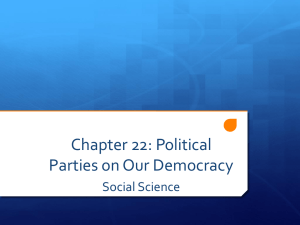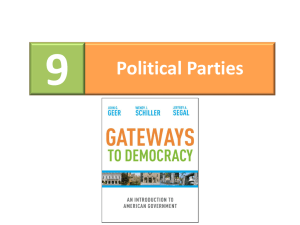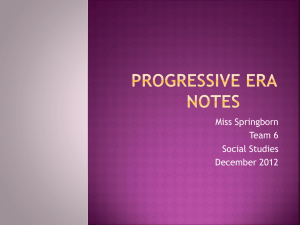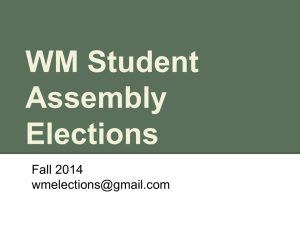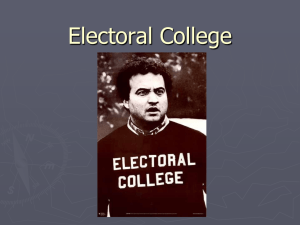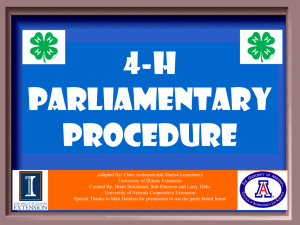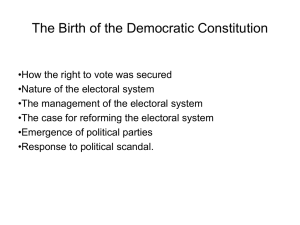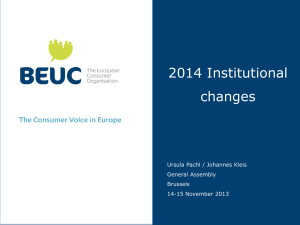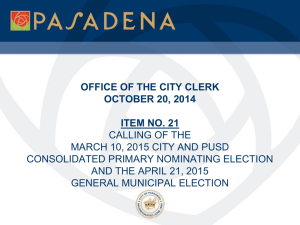Political Parties
advertisement
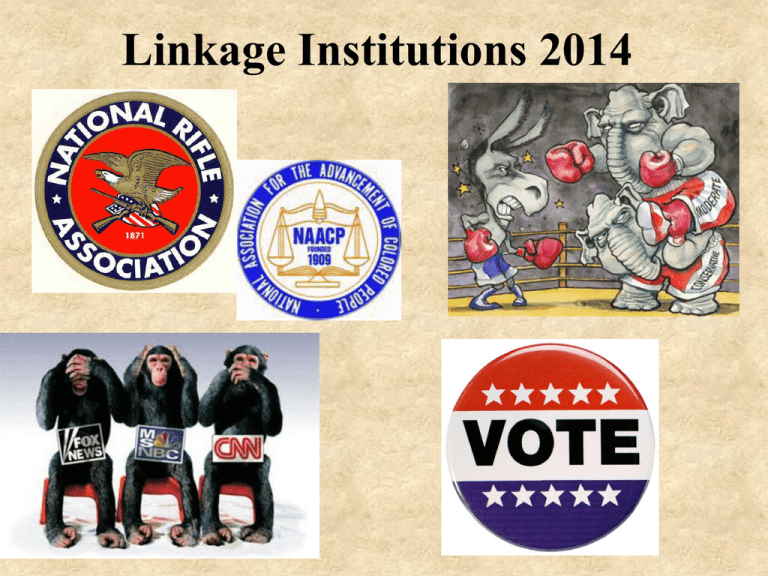
Linkage Institutions 2014 Basic Rotation of US Elections http://en.wikipedia.org/wiki/Elections_in_the_ United_States Illustrates diff types of federal elections Add to vocab • Candidate centered • Soft money • Gerrymandering Elections are CANDIDATE Centered—much more than most other liberal democracies candidate selection here is an individual decision as opposed to an organizational decision by a political party. Here, you run, you raise the money you get the signatures, you get yourself on the ballot and voters vote for you. Even if parities involved, they have little control due to the unique direct primary. Political Parties . . . In 1870, political cartoonist Thomas Nast depicted the Democratic Party with a donkey in a New York City-based magazine, "Harper’s Weekly." Andrew Jackson, a Democrat, had already used the donkey on posters during his 1828 presidential campaign In 1874, another Nast cartoon in "Harper’s Weekly" used an elephant to represent Republican voters who were dissatisfied with the prospect of President Ulysses S. Grant running for a third term. Nast used the elephant in another "Harper’s Weekly" cartoon two weeks later. Other political cartoonists picked up on the animals as symbols of their respective political parties. Today, the Democrats use the donkey as an unofficial symbol, while the Republicans officially adopted the elephant as their party mascot. Nast’s 1870 and 1874 cartoons are shown above. The Conventional Wisdom: Versus: George Washington in 1796 farewell address: “Let me warn you in the most solemn manner against the baneful effects of the spirit of party generally. This spirit . . . exists under different shapes in government, more or less stifled, controlled, or repressed; but in those of the popular form it is seen in its greater rankness and is truly their worst enemy.” Functions of Political Parties . . . Are they vital to liberal democracy? Elections: what is liberal democ w/o competitive elections? • • • • • • Nominate candidates (but . . . rise of primaries weakens them) Unify diverse interests key diff b/w them and Igs; By bringing together diff people and Raise funds for their candidates (but . . . ideas they help establish the means by Superpacs) (electioneering) which a majority can rule—w/o them Run Campaigns (but candidate centered—use the pol process would be too fragmented; but b/c they are a media) (electionereing) relatively heterogeneous group, they Provide a platform of issues also prevent tyranny of the majority Mobilize voters: Registering and GOTV and act as a modifying inflence Giving cues to voters What’s democracy w/o voters? Linkage Institution Organizing Government • Articulate policies • The party is essentially a link between the citizen and the state; party is one of the devices which makes possible citizen influence on the policies of government. what is democ w/o citizen control? Coordinate policy making The Media and Campaigns In the US, campaigns are much more candidate centered—and less based on the _________ __________ Why? Media coverage: horserace aspect, polls, feeding frenzy, coverage of candidates background, focus on candidate gaffes Candidates have contributed to this: use media to bypass parties, sound bites, media events, negative commercials against opposing candidates, leaking information, image building (hiring consultants, picture of families , going on talk shows) Interest groups contribute: 501c (3) g0rups and 527 groups like SwiftBoat Veterans for Truth and Move on; remember independent expenditures and “issue” ads: see articles and expenditureshttp://www.opensecrets.org/527s/index.php But will Citizen’s United change this to be . . . . Interest group centered? Things to remember about American Political Parties . . . . Our parties are relatively weak compared to other liberal democracies . . . Meaning: Decentralized—organized as a stratarchy Stratarchy is an organization in which each strata (or layer) is independent of every other strata. Each unit within a strata also is independent of every other unit within that strata. Meaning . . . They can’t call for elections, their governing power might be weakened by divided government, they don’t have many ways to discipline members who don’t vote the party platform, and anyone can say they are running on their ticket—like it or not In other systems, (like Canada), a bad party member can be relegated to the back bench, s/he won’t get “parachuted” into a safe seat, some systems even say you can lose your seat if you don’t vote with the party and the biggest consequence of all: if govt loses something they have designated a “vote of confidence” new elections mean the MP may lose his or her seat Why are parties weak? •Federalism •Separation of powers •Primaries •Political culture •pluralism (many access points) •Lots of media outlets (don’t need parties to get message out) •Stronger Igs (other options) •NO MORE SOFT MONEY It is an election by secret ballot in which voters choose a political party’s candidate for office in an election . an election that narrows the field of candidates before an election for office http://robinrobinsonforjudge.com/primary-sample-ballotsrepublican-and-democratic/ to see an example of a primary ballot • _________primaries (or pick-a-party) are those in which voters of any affiliation may vote for the slate of any party. • ________primaries are those in which only the voters affiliated with a party may vote in its primary. • ________primaries (or “jungle primaries” “free love” primaries) are those in which voters, regardless of affiliation, may choose the party primary in which they want to vote on an officeby-office basis. The blanket primary was struck down in 2001 by the Supreme Court in CA Democratic Party v. Jones. Cartoon from the 1934 campaign to create a blanket primary See what we ended up with in Wa State http://www.kitsapgov.com/aud/elections/archive/12/PRIM0812%20 Sample.pdf Witness the sleazy fisher http://www.co.pierce.wa.us/DocumentCenter/View/2877 State To Appeal Blanket Primary Ruling Published: Sep 19, 2003 OLYMPIA - Washington state will appeal a federal court decision that abolished the state's popular 68-year-old blanket primary that allows voters to split their tickets and avoid party registration. Secretary of State Sam Reed, a Republican, and Attorney General Christine Gregoire, a Democrat, announced Friday that the state will ask the full 9th U.S. Circuit Court of Appeals to rehear the decision made by one of its three-judge panels. The political parties called the new appeal a big waste of taxpayer money on a challenge that has no chance of succeeding. The appeals panel, drawing from a U.S. Supreme Court decision that threw out a virtually identical system in California in 2000, said allowing all registered voters to pick nominees clearly violates the parties' constitutional right to pick their own standard bearers. Are primaries for congressional seats direct or indirect? indirect primary noun U.S. politics. a primary in which members of a party elect delegates to a party convention that in turn elects the party's candidates. direct primary — n ( US ) government a primary in which voters directly select the candidates who will run for office A few points about elections for congress: ALL primaries for Members of Congress are direct elections but voter qualification criteria varies The primaries for the nomination of presidential candidates are INDIRECT General election ballot • http://www.kitsapgov.com/aud/elections/arc hive/12/Sample%20Ballot.pdf • Also to find your legislator: http://app.leg.wa.gov/DistrictFinder/ The history of soft money . . . Buckley v. Valeo" (1976) ruled that contributions to campaign known as “hard money” could be regulated. "Soft money" came to refer to unregulated money donated to political parties that was supposed to be used for state and local elections and generic “party-building” activities, including voter registration campaigns and get-out-the-vote drives. Soon it also was used for “issue ads” It was not regulated. Why issue ads? Buckley v. Valeo also held that only speech that expressly advocated the election or defeat of a candidate could be regulated (but not a discussion of issues) the distinction between “issue ads” and “election communications” • Candidate X runs an ad that says, "I am a good person. Candidate Y is a bad person. Vote for me on election day." Because of the "Vote for me..." portion . . . "hard money." • Candidate Y runs an ad that says, "Candidate X has a record that includes awful things. If these awful things continue, people will come to your house, steal your money and shoot your dog. Be sure to vote on election day.“ No express advocacy so it is an “issue ad” and can be paid for with soft money So soft money made parties stronger. . . . . But The McCain Feingold Act (the BCRA) banned soft money. . . Why are parties weak? • . . . parties have less money to spend on e__________ function • As a result, many of the soft money-funded activities previously undertaken by political parties have been taken over by independent expenditure groups (SUPERPACS). Why are parties weak? They can’t compete with superpacs Bring Back the Smoke-Filled Rooms? The campaign-finance laws have made the presidential selection process a self-destructive mess. The question asked everywhere is, Why is this the field? How did it come to this? Desperate questions bring desperate answers, such that I have been overheard mumbling of late: "Maybe it's time to bring back the smoke-filled rooms." This was the nearly mythical system of selection in which party leaders and party bosses gathered over cigars, bourbon and branch to pick a candidate "who could win." The most famous smoke-filled room pick was William McKinley, anointed for the 1896 election by Ohio kingmaker Mark Hanna (though in fact Hanna got McKinley nominated over the opposition of GOP party bosses). http://s.wsj.net/public/resources/images/ED-AO613_wl2101_G_20111130151910.jpg Effect of Weak Parties . . . Hard for voters to indicate an approach to governing: Hard to hold one party responsible Elected officials don’t do what party platform says Tendency to middle But . . . may lend itself to stability, be a better way to meet needs of all, and is in keeping with our individual emphasis Review: Party functions Our parties are weak for many reasons but with a focus on media, primaries and campaign finance laws What’s the diff b/w parties supporters platforms Rising partisanship “Safire’s New Political Dictionary” defines a smoke-filled room as “a place of political intrigue and chicanery, where candidates are selected by party bosses in cigar-chewing sessions.” Is there a “dimes worth of difference b/w the parties? Consider ideology http://blogs.kqed.org/lowdown/2012/11/06/t he-10-biggest-differences-betweenrepublicans-and-democrats/ Consider supporters Religiosity The Gallup Religiosity Index, 2009. (light color indicates religious, dark nonreligious)[1] Safety Net Policies Programs indented to protect from hardship or loss or to guarantee a minimal amount of physical, or financial security • See other ahem . . . Cleavages http://www.cnn.com/election/2012/results/rac e/president http://www.washingtonpost.com/wpsrv/special/politics/2012-exit-polls/table.html http://www.washingtonpost.com/wpsrv/special/politics/2012-exit-polls/nationalbreakdown/ http://www.gallup.com/poll/154559/USPresidential-ElectionCenter.aspx?ref=interactiveack Potassium feldspar (orthoclase) is often pinkish in color and displays the property of cleavage, the tendency to break along flat planes. It is harder than glass example Pick 2 cleavages (race, gender, education etc) and 2 sides. Explain why each side in the cleavage might prefer the candidate they do, given the platforms of the respective parties. Cleavage one: Education level Side a: high school graduate Side b: Post-graduate degree Cleavage two: Side a Side b Reinforcing and Cross-Cutting Cleavages Societal cleavages (e.g. race, class, religion, gender, region, etc) can produce conflict and disagreement among the population over politics and policy. Reinforcing Cleavages •If cleavages overlap with each other, this can heighten the conflict and be more divisive. •The disagreements produced by one division (e.g. class), will reinforce the divisions produced by another (e.g. race). •Finding agreement and compromise across groups in this situation can be that much more difficult. Cross-cutting Cleavages •If cleavages cut across each other, this can lessen the presence of conflict across groups •Disagreements produced by one division can produce cross-pressures for individuals and mitigate the divisions they may experience by way of another cleavage •Cross-pressures help produce "bridges" across the cleavages, making agreement and compromise more likely See images to illustrate: http://desart.us/courses/3180/cleavages.html Gender Gap in 2012 Vote Is Largest in Gallup's History by Jeffrey M. Jones PRINCETON, NJ -- President Barack Obama won the two-party vote among female voters in the 2012 election by 12 points, 56% to 44%, over Republican challenger Mitt Romney. Meanwhile, Romney won among men by an eightpoint margin, 54% to 46%. That total 20-point gender gap is the largest Gallup has measured in a presidential election since it began compiling the vote by major subgroups in 1952. . . . There are a number of possible reasons for the increase in the gender gap this year. For example, Romney's business background may have been more appealing to men than to women. Obama's campaign stressed maintaining the social safety net, raising taxes on the wealthy, maintaining abortion rights, and requiring healthcare coverage for contraception -- all in contrast to Romney's more conservative positions on these issues of potential interest to women. Groups are not monolithic either Latino/a vote by ancestry See also http://wwwpersonal.umich.edu/~mejn/ele ction/2012/ Reminds me of “the most important candidate quality” in exit polls The White Vote For a reflection see: By Karl Rove June 27, 2013 More White Votes Alone Won't Save the GOP To win the presidency in 2016, the party needs to do better with Hispanics. http://online.wsj.com/news/art icles/SB10001424127887323 873904578569480696746650 Parties are COALITIONS (a) Describe three groups that were significant in President Obama's electoral coalition and explain why each was important (b) Describe the problems that President Obama may have in sustaining his winning coalition The parties themselves have divisions with in them . . . Here Come the Economic Populists November 26, 2006 Fiscal vs Social Conservatives • would argue that the government should be small, especially when it comes to taxation, government expenditures and deficits, and government debt VS. . . . • Argues that government and/or society have a role in encouraging or enforcing what they consider traditional values or behaviors November 27, 2011, 11:34 pm 509 Comments The Future of the Obama Coalition By THOMAS B. EDSALL For decades, Democrats have suffered continuous and increasingly severe losses among white voters. But preparations by Democratic operatives for the 2012 election make it clear for the first time that the party will explicitly abandon the white working class. All pretense of trying to win a majority of the white working class has been effectively jettisoned in favor of cementing a center-left coalition made up, on the one hand, of voters who have gotten ahead on the basis of educational attainment — professors, artists, designers, editors, human resources managers, lawyers, librarians, social workers, teachers and therapists — and a second, substantial constituency of lower-income voters who are disproportionately African-American and Hispanic. Next Points • Parties are more distinct • Growing Partisanship—why and ramifications • We have a 2 party dominant System What does this define? Firm adherence to a political party Contrast this: Of, consisting of, or supported by members of two parties, especially two major political parties The parties are becoming more distinct . . . . From the Economist: Motion dismissed Jul 14th 2005 American politics is both too rigid and too flexible AMERICAN society has been getting less like Europe's. It is growing faster and ageing more slowly, it is geographically more mobile and (dare one say it) has become more divided between rich and poor. Yet at the same time, the structure of American politics (though not its ideology) is getting more “European”. Political parties are becoming more coherent in their beliefs, and the system of government is more centralised. . . . This does not mean that party structures themselves have strengthened. In fact, in terms of raising money they are weaker than they have been throughout most of American history. But the parties are ideologically more distinct. And within the parties, politicians are more partisan and less diverse in their backgrounds. . . . American parties used to be ad hoc cliques and loose regional coalitions. Party grandees chose likely candidates on the basis of patronage and loyalty, not ideology. But the defection of conservative southerners from Democrats to Republicans—and the mirror-image move of north-eastern Republicans to Democrats—made both parties' ideologies much clearer. Now almost all conservatives are Republican and almost all liberals are Democrats. When George Wallace was governor of Alabama, he used to say that there wasn't a dime's worth of difference between the parties. You could not say that now. Above all, polarisation has grown in the electorate, evidenced by a sharp decline in split-ticket voting (choosing a president from one party and a congressional representative from another). In 1972, 44% of congressmen and women represented a different party from the one whose presidential candidate carried their district. In 2000, the share was under 20%. The truly independent voter seems to be disappearing. That may seem curious, because those who call themselves independents easily outnumber self-identified Democrats or Republicans. Yet most so-called independents vote consistently one way or the other. The White House reckons that less than one-third of independent voters actually switched parties in the past three elections. With the decline of swing voters, there seems less and less point in running presidential campaigns to appeal to the slim middle. Instead, elections have become contests to mobilise core supporters. Rising partisanship-why? •Shrinking political center as parties get more homogenous •Redistricting creates safe seats •Govt controlled by slim majority so imperative that loyalty be enforced •Congressional lifestyles—fewer live in DC so don’t socialize •Money: more time needed to raise money, so don’t socialize •Media lives on accentuating, and in some cases manufacturing, differences. “The twenty-four/seven media cycle means policymakers must take more time to feed the beast.” •American public: see Pew Research values study Rising partisanship A party-line vote in a deliberative assembly (such as a constituent assembly, parliament, or legislature) is a vote in which every member of a political party votes the same way (usually in opposition to the other political party(ies) whose members vote the opposite way). See the vote on Obamacare: https://www.govtrack.us/congress/votes/111-2009/s396 Partisan Polarization Surges in Bush, Obama Years Trends in American Values: 1987-2012 http://www.people-press.org/2012/06/04/partisanpolarization-surges-in-bush-obama-years/ In recent years, both parties have become smaller and more ideologically homogeneous. Republicans are dominated by self-described conservatives, while a smaller but growing number of Democrats call themselves liberals. Among Republicans, conservatives continue to outnumber moderates by about two-to-one. And there are now as many liberal Democrats as moderate Democrats. Few people recognize that the previous bipartisan era was an aberration, not the historical norm. Consider, for instance, this plot of estimated party polarization in Congress: Redistricting creating safe seats As the economist says . . .. . . In a normal democracy, voters choose their representatives. In America, it is rapidly becoming the other way around www.economist.com/world/na/displayStory.cfm?story_id=1099030 How does redistricting create a growing partisanship in Congress . . . Again, from another Economist article: Partisanship is also evident in redistricting, which has increased the number of safe seats towards North Korean levels. In 2004, only 30-40 congressional seats are likely to be truly competitive—a quarter of the number in the 1990s. Since 1964, the share of House incumbents re-elected with over 60% of the vote has risen from 58% to 77%. This makes congressmen's politics more extreme. If your district is rock-solid, you have little reason to fear that voters will kick you out for moving too far from their opinions. The main threat comes from party activists, who tend to be more extreme in their views and can propose a challenger in primary elections. So the dangers of drifting too far to the middle outweigh those of drifting too far to the extremes. Partisan redistricting marginalises centrist voters, aligns the views of candidates more closely with extremists on each side and radicalises politics See the following: explains packing and cracking http://ed.ted.com/lessons/gerrymandering-how-drawingjagged-lines-can-impact-an-election-christina-greer And CPJ Grey: http://www.youtube.com/watch?v=Mky11UJb9AY Gerrymandering should not be confused with malaportionment, where the number of eligible voters per elected representative can vary widely Result of redistricting . . . “safe seats” which means: Elections less competitive Incumbent advantage enhanced More partisanship . Rising partisanship plus divided government leads to . . .. effects of partisanship in Congress. . . Confirmation battles leading to declining judicial confirmation rates and 100s of posts not filled More effects . . . Rise of the filibuster At first, “filibuster” referred to a “free booter” or “pirate”, who engaged in illegal activities for self gain; then it became “an endless discourse to impede the passage of an ‘unwanted’ congressional bill”. And more effects Effect of Divided Govt. especially when coupled with more partisanship Gov’t shutdown of 95-96; 2013 BUT GRIDLOCK was the founders point Other things to remember about parties . . . We have a 2 party system Why? But also American political culture: not ideological, no history of anti-capitalism, strong IG give other options Third Parties have a lot of disadvantages: Lack name recognition Ballot access harder No matching funds in presidential races (unless party got 5% of the vote in last election) Perception of “wasted vote” Excluded from debates (unless 15% support) Lack organization If your support is spread out, WTA hurts you • Notable Third Party Candidates •Ross Perot (Reform Party). A Texas billionaire with no experience in government, Perot captured public attention during the 1992 election for his focus on the budget deficit and his promises to bring his corporate successes to the White House. Perot participated in three presidential debates against Bill Clinton and George H. Bush, and won about 18 percent of the popular vote (studies have shown that Clinton probably would have still won had Perot not run, though Perot did cost Clinton a majority of the popular vote). Perot ran again in 1996 but with less success; he was not invited to participate in the presidential debates between Clinton and Bob Dole, and won about 8.4 percent of the vote. •. Ralph Nader (Green Party). A long-time consumer advocate, Nader first ran in 1996 with a nominal campaign but became a more active candidate in 2000, saying that he was both criticizing the Democratic Party as well as trying to build the Green Party as a viable and stable third-party. Nader won about 2 percent of the popular vote in 2000 Representative John Anderson of Illinois (National Unity Campaign). Originally a moderate Republican, Anderson dropped out of the 1980 Republican primary in favor of Ronald Reagan, but continued his campaign as an independent candidate. He participated in one presidential debate with Reagan (Carter refused to debate Anderson), and won about 6 percent of the popular vote. •Governor George Wallace (American Independent Party). The last third-party candidate to win any electoral votes, Wallace split from the Democratic Party to run a campaign against the extension of civil rights and in favor of the Vietnam War. He had strong results in the South and won 13.5 percent of the popular vote and 48 electoral seats. Wallace subsequently returned to the Democratic Party. Gov. George Wallace blocks the doorway to Foster Auditorium at the University of Alabama in Tuscaloosa, June 11, 1963. Even though they don’t win, third parties do play an important role in our political system • bring new groups into the electorate • act as "safety valves" • raise issues that other parties must address and often incorporate into their own party platforms And they can be “spoilers” influencing election results This is what you should have learned thru class discussions • Party functions/ why need in lib democracy • Our parties are weak for many reasons but with a focus on media, primaries and campaign finance laws • What’s the diff b/w parties supporters platforms • Rising partisanship • Parties are more distinct • Growing Partisanship—why and ramifications • We have a 2 party dominant system—but thirds aren’t irrelevant How Bill Changed the Dems 1999-2001 (election 1998) still divided: D president; R congress 2001-2003: (election 2000) R pres; R house; R senate which becomes D senate; * (50/50 after election, but who was a tie breaker. . . So R control until Jeffords switches to be an independent so 50 dems, 49 Rs and 1 independent) 2003-2005; (election 2002) R pres, R senate 51/48/1; R House (party govt) 2005-2007: (election 2004)R pres; R senate; R house 2007-2009 (election 2006) what happened? ___ Pres; _______ Senate; ____ House See: http://www.cnn.com/ELECTION/2006/ http://uspolitics.about.com/od/usgovernment/l/bl_party_division_2.htm
